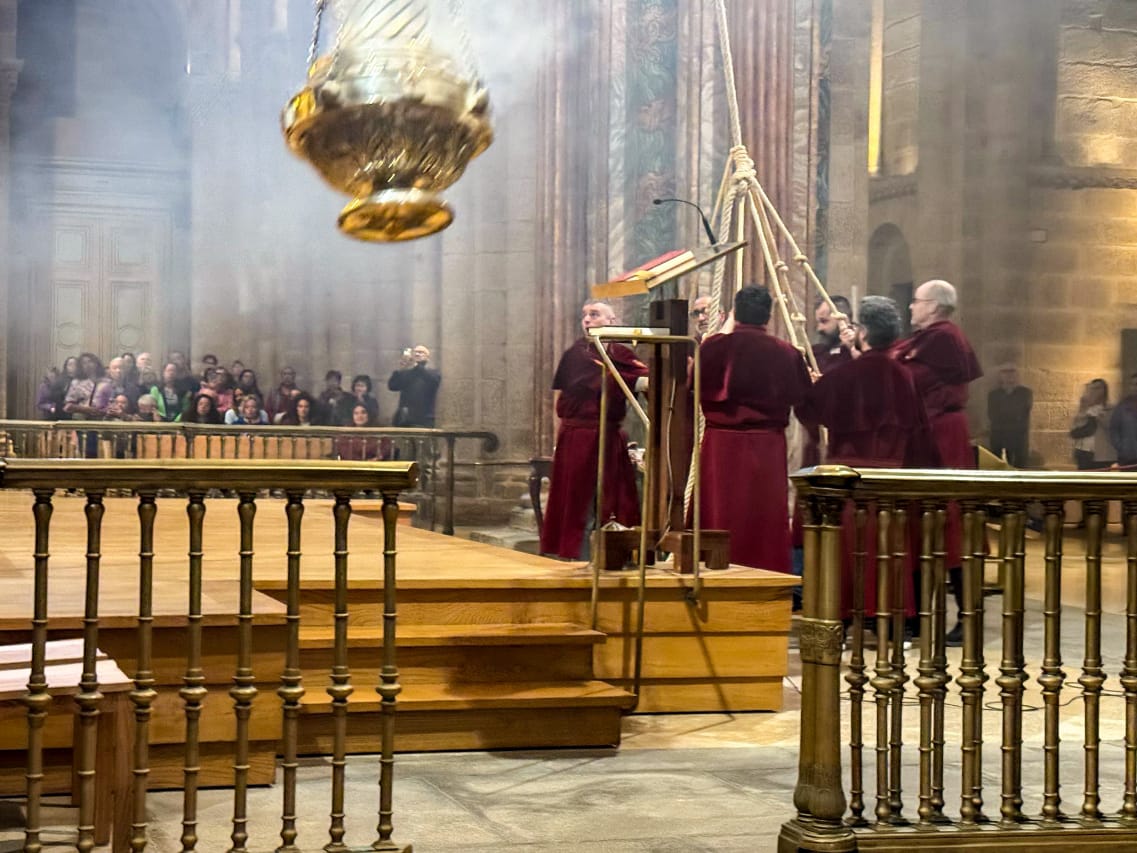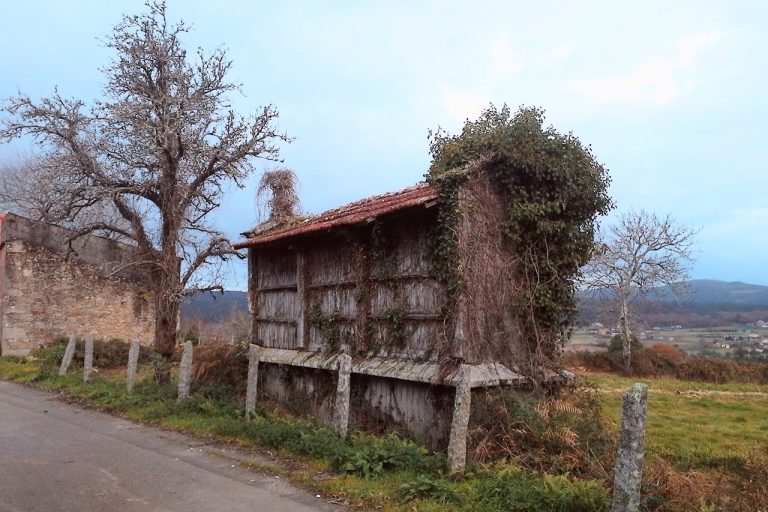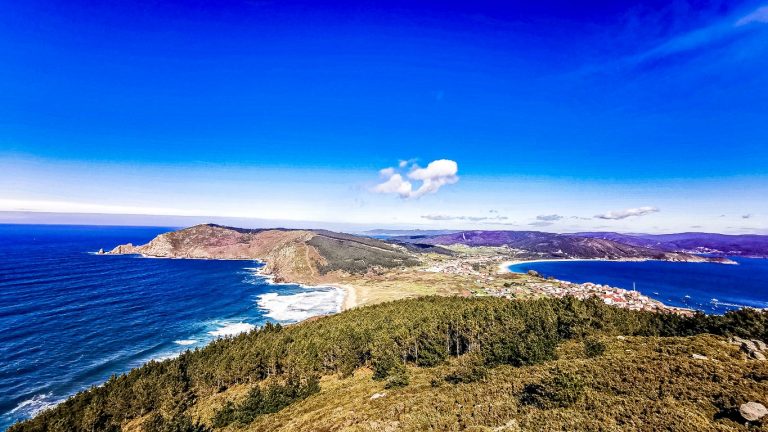
A New Stage – Beginning & Mood
The morning on Monte do Gozo is a special moment. Many pilgrims rise in the half-light to catch the first rays of sun above the towers of Santiago. The wind carries the scent of eucalyptus and wet grass, and your heart beats faster—only a few kilometers separate you from the cathedral.
It is not a day of fatigue, but of awe. Every step from Monte do Gozo to Santiago is a step into the goal. You know: the way is almost complete, but its true meaning begins only now.
Route & Elevation Profile
- Distance: 4.1 km
- Elevation gain: hardly relevant, gentle descent into the city
- Difficulty: low
- Character: a short, urban final sprint with deep symbolic power
The path leads almost entirely through the suburbs and then into the old town of Santiago—paved, well marked, and accompanied by the steadily growing rhythm of urban life.















Variants & Small Alternatives
There are hardly any variants—the path follows the historic route. Only one question arises:
- Set off early: Those wishing to attend the pilgrim’s mass at 12 noon should leave in good time to avoid queues.
- Walk slowly: Many pilgrims choose to walk the last kilometers deliberately slowly, even in silence, to experience the arrival more deeply.
Description of the Way – With All Senses
From Monte do Gozo you descend, leave the large pilgrim complex, and head towards San Lázaro. Here you first feel urban life: cars, people, voices—a strong contrast to the quiet paths of the past days.
Through As Fontiñas, the Camino takes you across modern neighborhoods before you reach the Rúa dos Concheiros. From here, the atmosphere changes: small shops, cafés, the smell of coffee and pastries accompany your steps.
At the Porta do Camiño, the historic gate of the medieval city wall, you enter the old town. Cobblestones crunch beneath your boots, the narrow streets echo with the voices of other pilgrims, students, and locals. The Rúa de San Pedro leads you into the heart of the city, past the Plaza de Cervantes and along the Rúa da Acibechería.
Finally, you pass through the Arco de Xelmírez—and stand in the Praza do Obradoiro, directly in front of the cathedral. A sea of emotions bursts forth: tears, embraces, silent prayers. This is the goal, and at the same time a new beginning.
Intermediate Places & Special Features
| Place | Distance from Monte do Gozo | Feature | Tip |
| San Lázaro | 1 km | modern suburb, congress center | Short stop for a coffee |
| As Fontiñas | 2 km | residential neighborhood | Refill water |
| Rúa dos Concheiros | 3 km | transition to the old town | Enjoy first glimpse of pilgrim life |
| Porta do Camiño | 3.5 km | historic city gate, entrance to old town | Focus on the ancient walls |
| Praza do Obradoiro | 4.1 km | cathedral, heart of the Camino | Arrive, pause, breathe |

























Packing & Shopping Tips
Today you need only the essentials: water, perhaps a small breakfast. Carry your best spirit—it is a day of celebration. Tip: Many pilgrims lay down their shell or pilgrim’s staff in front of the cathedral—as a symbol of completion.
Food, Lodging & Services
- Monte do Gozo: large pilgrim accommodations.
- Santiago de Compostela: countless options—from simple albergues to guesthouses to the legendary Hostal de los Reyes Católicos.
The old town is full of restaurants and bars—from traditional tapas bars to upscale dining.
The Special Today – Santiago de Compostela
Today there is no “special,” for the entire day is extraordinary. Entering Santiago is not just another stage point, but the culmination of the entire Camino. Everything that came before—the long roads of Castile, the mountains of León, the mists of Galicia—condenses here in a single moment. Every step through the streets carries the weight of arrival, every glance is filled with centuries of hope, prayer, and story.
The Porta do Camiño recalls old Santiago, a city founded for the Apostle himself. Whoever passes here feels the history of a thousand years of pilgrimage. You do not simply walk into a city—you cross an invisible threshold: between journeying and arrival, between longing and fulfillment.
The legends surrounding this place are part of the experience. In the 9th century, a hermit saw mysterious lights in the forest of Libredón, revealing the Apostle’s tomb. Thus arose the Campus Stellae—the Field of Stars. And without the fabled Queen Lupa of Fisterra, who at first resisted, sent wild bulls, and finally, overwhelmed by divine signs, granted passage, the relics would never have arrived here. Santiago was born of light, resistance, and grace—and that can still be felt today.
In the 11th century the cathedral’s foundations were laid. In the 12th century, Master Mateo completed the Pórtico de la Gloria, a symphony in stone where prophets, angels, and apocalyptic scenes welcome the pilgrim. Later, the baroque towers rose, like fingers of granite touching the sky. Each epoch left its mark—Romanesque, Gothic, Baroque—and together they form a building that is more than architecture: a sacrament in stone.
Then the Praza do Obradoiro opens before you. Four sides, four faces of Europe: politics in the Pazo de Raxoi, knowledge in the Colegio de San Xerome, charity in the Hostal de los Reyes Católicos, and faith in the cathedral. Here everything comes together: power and mercy, history and future. Pilgrims laugh, burst into tears, throw themselves on the ground, or lie quietly on the stones to gaze at the towers above them. There is no “right” reaction, only the knowledge: I am here.
And then the cathedral itself: the goal of millions of pilgrims for over a millennium, the heart of all ways. Even the entrance through the Pórtico de la Gloria feels like a passage from the world of the ordinary into eternity: angels, prophets, and saints await you, as if they had been waiting all these years only for you. You ascend the steps and place your hands on the shoulders of the Apostle. It is a gesture made by millions before you—and yet, in this moment, it is only yours: unique, inexpressible. Gratitude, plea, joy, exhaustion—all merge in this embrace. Then comes the descent into the crypt: the silver shrine, the flicker of candles, the cool stone. There, at the saint’s tomb, you pause, as generations of pilgrims have paused before you. It is a moment words can scarcely capture—for it is greater than language. Here your story merges with the stream of twelve centuries.
And then that simple yet deeply moving moment: the pilgrim’s office. You hand over your Credencial, and each stamp tells a chapter—a hostel, a village, a day of your life. Finally, you receive it: the Compostela. A sheet of paper, written in Latin, modest and plain—and yet heavy with all your steps. Some raise it like a flag, others fold it silently, tears in their eyes. But all know: it was not in vain.
In the evening, the great final chord sounds: the Botafumeiro swings through the transept of the cathedral. A silver censer, as large as a child, flies like a pendulum from one end to the other. Smoke rises in golden waves, the choir sings, the bells ring. For a moment, heaven and earth touch. It is as if the Camino itself is sealed—in incense, light, and sound.
But Santiago is not only sacrament—it is also daily life. In the Rúas do Franco, do Vilar, and Nova, the air smells of pulpo á feira, of wine, of bread. Bagpipes play, students hurry, children laugh, pilgrims raise a toast. Since 1985 the city has been a UNESCO World Heritage Site, not only for its architecture but because it is a living memory of Europe—a place where past and present, faith and life intertwine.
And so Santiago shows you at the end: it is both goal and mirror. Some pilgrims continue on to Fisterra, the “end of the world.” Others remain here, embraced by the squares, the bells, the shadows of all who went before them. But all carry something away: the star of Libredón, which once shone in the sky and now burns on in their hearts.



















Reflection at Stage’s End
Only four kilometers—and yet the greatest distance of your life. Between Monte do Gozo and the cathedral lies not only a path, but the completion of a journey that resonates within you. Perhaps you feel joy, perhaps emptiness, perhaps gratitude. Yet in all these feelings, one thing is shared: you have arrived.
📊 Tabular Overview
| Stage | Start | Goal | Distance | Elevation gain | Difficulty | Intermediate Places |
| 33 | Monte do Gozo | Santiago de Compostela | 4.1 km | negligible | low | San Lázaro, As Fontiñas, Rúa dos Concheiros, Porta do Camiño |
🌌 Camino of the Stars – Stage 33
Monte do Gozo → San Lázaro → As Fontiñas → Rúa dos Concheiros → Porta do Camiño → Praza do Obradoiro (Cathedral).
What was your moment of arrival like? Did you cry, laugh, or simply remain silent? Share your story—it belongs to the stars of the Camino.











